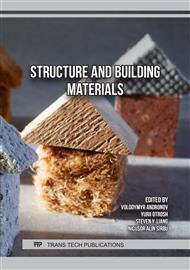[1]
P. Business, E. Date, R. No, and P. Business, "Special release 2018," vol. 409, no. April, p.2–9, 2021.
Google Scholar
[2]
S. Zafar, "Agricultural Wastes in the Philippines," BioEnergy Consult. 2015.
Google Scholar
[3]
K. J. Shinners and B. N. Binversie, "Fractional yield and moisture of corn stover biomass produced in the Northern US Corn Belt," Biomass and Bioenergy, 2007.
DOI: 10.1016/j.biombioe.2007.02.002
Google Scholar
[4]
Marcela M. Bungag, "Acceptability of corn zea mays husk fiber as raw material in fabric making," Asia Pacific High. Educ. Res. J., 2018.
Google Scholar
[5]
N. Reddy and Y. Yang, "Properties and potential applications of natural cellulose fibers from cornhusks," Green Chem., 2005.
DOI: 10.1039/b415102j
Google Scholar
[6]
K. A. Paynor, E. S. David, and M. J. G. Valentino, "Endophytic fungi associated with bamboo as possible sources of single cell protein using corn cob as a substrate," Mycosphere, 2016.
DOI: 10.5943/mycosphere/7/2/5
Google Scholar
[7]
M. Velasco, "Consumers warned of soaring electric bills in summer months.pdf." Manila Bulletin, Philippines, 2022, [Online]. Available: https: //mb.com.ph/2022/03/13/consumers-warned-of-soaring-electric-bills-in-summer- months/.
Google Scholar
[8]
K. Pandecha, A. Pongtornkulpanich, S. Sukchai, and T. Suriwong, "Thermal properties of corn husk fiber as insulation for flat plate solar collector," J. Renew. Energy Smart Grid Technol., 2015.
Google Scholar
[9]
C. Rojas, M. Cea, A. Iriarte, G. Valdés, R. Navia, and J. P. Cárdenas-R, "Thermal insulation materials based on agricultural residual wheat straw and corn husk biomass, for application in sustainable buildings," Sustain. Mater. Technol., 2019.
DOI: 10.1016/j.susmat.2019.e00102
Google Scholar
[10]
J. Zach, A. Korjenic, V. Petránek, J. Hroudová, and T. Bednar, "Performance evaluation and research of alternative thermal insulations based on sheep wool," Energy Build., 2012.
DOI: 10.1016/j.enbuild.2012.02.014
Google Scholar
[11]
N.H.B.A. Rassdi, "Cellulosic-Based Packaging Material from Corn Husk," Int. Mig Rev., 2013.
Google Scholar
[12]
Price, "INVESTIGATING EFFECTS OF INTRODUCTION OF CORNCOB ASH INTO PORTLAND CEMENTS CONCRETE: MECHANICAL AND THERMAL PROPERTIES," Am. J. Eng. Appl. Sci., 2014.
DOI: 10.3844/ajeassp.2014.137.148
Google Scholar
[13]
I. O. Ohijeagbon, A. A. Adeleke, V. T. Mustapha, J. A. Olorunmaiye, I. P. Okokpujie, and P. P. Ikubanni, "Development and characterization of wood-polypropylene plastic-cement composite board," Case Stud. Constr. Mater., 2020.
DOI: 10.1016/j.cscm.2020.e00365
Google Scholar
[14]
P. K. K. M, G. D. Ghogare, N. B. Kirdakar, K. Mahadev, and G. A. Madhukar Nevase, "Mini Hydraulic Press," Int. J. Adv. Res. Sci. Commun. Technol., 2021.
DOI: 10.48175/ijarsct-1766
Google Scholar
[15]
EN 822, "Thermal Insulating Products for Building Applications - Determination of Length and Width." CEN, Brussels.
Google Scholar
[16]
EN 823, "Thermal Insulating Products for Building Applications - Determination of Thickness." Brussels.
Google Scholar
[17]
Eoghan Frawley and D. M. Kennedy, "Thermal testing of building insulation materials," Eng. J., vol. 61, no. 9, p.552–558, 2007.
Google Scholar
[18]
L.R.A. Mascariñas, R.M. Ureta, S. M. Mejico, and C. D. Servando, "Elaboration and Characterization of Thermal Insulating Material Based on the Synergy of Natural Coconut Husk and Disposable Diaper Pads Fibers," Int. J. Eng. Technol., 2019.
DOI: 10.18052/www.scipress.com/ijet.17.21
Google Scholar
[19]
C. Zheng, D. Li, and M. Ek, "Improving fire retardancy of cellulosic thermal insulating materials by coating with bio-based fire retardants," Nord. Pulp Pap. Res. J., 2019, doi: 10.1515/npprj-2018- 0031.
DOI: 10.1515/npprj-2018-0031
Google Scholar
[20]
European Committee for Standardization, "EN ISO 11925-2:2020 Reaction to fire tests – Ignitability of products subjected to direct impingement of flame – Part 2 : Single-flame source test," CEN, 2020.
DOI: 10.3403/02510382u
Google Scholar
[21]
A. Harshavardhan and L. Muruganandam, "Preparation and characteristic study of particle board from solid waste," 2017, doi: 10.1088/1757- 899X/263/3/032005.
DOI: 10.1088/1757-899x/263/3/032005
Google Scholar



